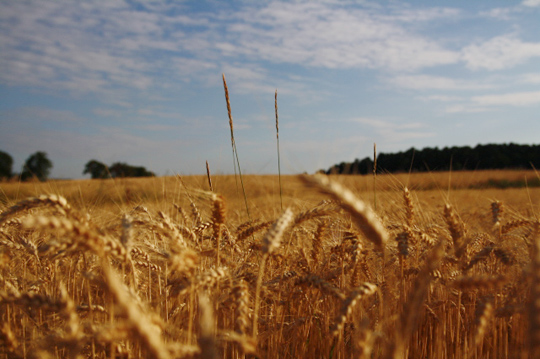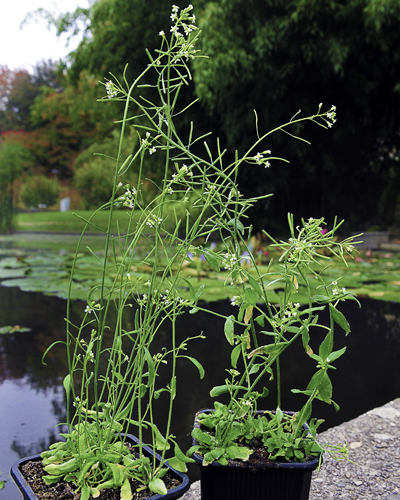Switch Off the Immune Brake
Freiburg, Jan 28, 2020
Plants in the wild are much more capable of combating infection and drought than they actually do. Dr. Marco Trujillo from the Institute of Biology II of the University of Freiburg is researching this “immune brake.” Crops that fight off threats with all their strength need less pesticides and are better equipped to handle the frequent periods of drought caused by climate change.

Crops will need be more robust in the future. Luckily, this capacity is already inherent in them. Photo: Max Orlich
It pays to fight back. However, combating stress and infections costs a large amount of the plant’s energy and resources. Plants in the wild have to compete with each other for light and the same limited nutrients. This means that sometimes plants are forced to apply the brake on their immune system to have more energy for growth. “However, this isn’t as critical in agriculture as it is in the wild,” says Dr. Marco Trujillo, who is an interim professor at the Institute of Biology II of the University of Freiburg. This is because farmers provide very favorable conditions for their crops, which also don’t have to compete with other plant species. Applying the immune brake in this case has therefore a negative effect, which is why Trujillo is researching how to turn it down.
Competition makes plants more vulnerable
“The goal is to apply our findings to crops,” Trujillo says. Currently, his research is limited to the model organism Arabidopsis thaliana, also known as thale cress or mouse-ear cress. So far, he and his team of five researchers have demonstrated that thale cress invests much more energy in defending itself against disease when a certain protein is switched off. With this “immune brake” off, the plant is also more capable of withstanding drought stress. “This is very important in terms of climate change, which is causing more and more extreme weather events for farmers,” says Trujillo. With the immune break switched off, crops would also be more capable of withstanding freak weather conditions and would need less pesticides.
Trujillo specializes in the research of proteostasis. “Imagine cells are spaces full of lots of different proteins,” he says. Each needs to have a certain concentration, which is different for every protein. These proteins also need to function in the right place. For this, they have to fold themselves correctly and be able to reach their work stations. If all three criteria are met, the cell is in balance. This is called protein homeostasis, or proteostasis. However, this is a very complicated process. Cells manage the production, folding, transport, and removal of proteins on many different levels. “Ultimately, it’s a tug-o-war between production and degradation,” Trujillo says.
Kiss of death for proteins
Trujillo is interested in protein degradation. “Cells get rid of more than just waste,” he says. Although proteins have an inbuilt expiration date, cells almost never wait that long. Instead, they start or end processes beforehand by breaking down proteins at the right time. An important switch in this process is ubiquitin. Trujillo says, “It is a key signal for when a protein will be broken down.” The signaling cascade often initiated on the cell surface by receptors. When exposed to external stimuli, these send signals to the interior of the cell. This in turn causes ubiquitin-conjugating enzymes, ligases, and the target protein to assemble into complexes where ubiquitination occurs. In this process, ligases and conjugating enzymes attach ubiquitin to proteins, thereby giving them the “kiss of death.”

Marco Trujillo relies on thale cress as a model organism. Photo: Thomas Kunz
However, not all ubiquitinated proteins are doomed for degradation,. Sometimes, only their activity changes, or they are transported to a new location within the cell. “Ubiquitin can form several types of chains,” says Trujillo, who studied microbiology in Bogotá, Colombia, and the University of Giessen before studying the immune system of plants as a postdoc researcher at Sainsbury Laboratory in the UK and the RIKEN Institute in Japan. Conjugating enzymes are involved in the building of different types of ubiquitin chains. Arabidopsis has 37 conjugating enzymes, but “we don’t know what kind of ubiquitin chain each and every one of them is responsible for,” Trujillo says, adding that, that these different ubiquitin chains are recognized and guided to their new assignments, “by mostly unknown factors.”
Boosting plants’ defenses
What is certain is that conjugating enzymes regulate the intensity of immune and stress responses in plants, but do this in combination with ubiquitin ligases. The protein Trujillo switched off in Arabidopsis to release the immune brake is one such ligase proteins. However, he points out that switching off this protein in order to enhance a plant’s ability to combat drought and infections is something that it could not afford in the wilderness. “It would not grow enough,” he says. Too much energy would go toward its immune and stress response. The modified thale cress would therefore be outperformed by stronger competitors and would fail to thrive. To prevent this, normally the plant’s cells use the ligase that Trujillo switched off to quickly degrade those receptors that send stress signals to the cell’s interior when threatened by disease or drought. The immune brake is therefore also a stress brake.
Ubiquitination and similar signaling cascades were recently the theme of the International Conference on Plant Proteostasis at the University of Freiburg in September 2019. “It was a huge success,” says Trujillo, who was in the organizing team. “We’re a young and fast growing community, and this was the first time we’d exchanged ideas at such a high level.” In his opinion, the conference has given the entire field of research its first major boost. The conference will now take place annually. Next year it will be in Madrid, Spain, then at different locations and in 2020 in Rhode Island , U.S.A.
So how do ubiquitination complexes receive stress signals? Which conjugates trigger which ubiquitin chains? These are only some of the questions Trujillo hopes to answer soon in his attempts to solve the mystery of the biochemical processes of ubiquitination in Arabidopsis. A second major goal is to establish a systems biology approach. “We are transferring the ubiquitin cascade in Arabidopsis to bacteria, so that they can ubiquitinate,” he says. This system will allow him to intervene in the cascade and to test inhibitors and stimulators more easily with the goal of developing future applications.
Jürgen Schickinger

